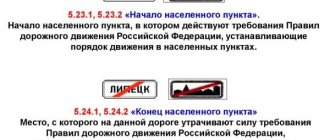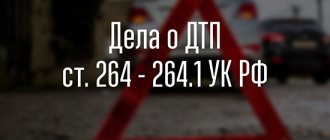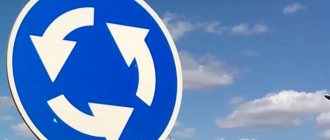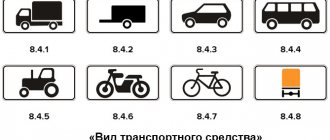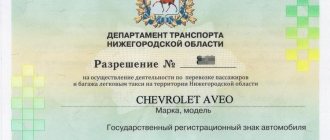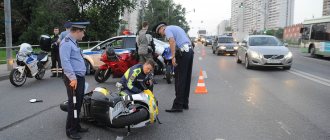Drivers must remember to comply with traffic rules, not only when driving their car, but also when leaving it in parking lots, parking lots, roads, etc. Particular attention should be paid to parking in the oncoming lane. Failure to comply with legal requirements regarding leaving a vehicle in this manner can lead to very unpleasant consequences for motorists in the form of a fine.
To avoid getting into trouble, motorists are encouraged to read the article about the rules for parking in the oncoming lane, as well as the penalties for violating them.
How to stop and park in oncoming traffic correctly
On the left side of the road, and therefore, in the presence of two-way traffic on the oncoming lane, according to clause 12.1 of the Russian Federation Traffic Regulations, it is allowed to stop and park exclusively in populated areas and only on those roads that have one lane each for the oncoming and oncoming directions. An essential condition for legal parking on oncoming traffic is the absence of tram tracks in the middle . In one-way traffic, the same rules apply for stopping and parking on the left as for parking on the right. However, vehicles whose weight exceeds 3.5 tons can stop only when unloading and loading are necessary (for example, bringing goods to a store, delivery service, etc.).
Clause 12.2 of the Russian Traffic Regulations covers the correct methods for parking a vehicle. It says that parking cars on the roads is only allowed in a parking lot parallel to the roadway and in one row . Only two-wheeled vehicles that do not have a side trailer are allowed to park in two rows. In another way, that is, at an angle to the roadway, parking can only be done if there is a permitting road sign depicting the method of parking the vehicle and road markings provided for this section of the road. In addition, the parameters of the roadway section must allow the vehicle to be parked in this way. It stands for parking; if there are no signs specifying how to park the vehicle, the car should only be parked parallel to the roadway, otherwise the rules will be violated.
For cars, motorcycles, mopeds and bicycles, parking may also be permitted on the edge of the sidewalk bordering the roadway, but only if a “Parking” road sign is installed in this place together with one of the signs depicting the permitted method performing a maneuver.
Read more about parking at the pedestrian crossing by following the link.
Driving on the wrong side of the road - fine or deprivation of license?
So, driving on the side of the road is prohibited. Only stopping and parking on the side of the road is permitted, subject to exceptions. The fine for driving on the side of the road is 1,500 rubles (Part 1 of Article 12.15 of the Administrative Code). It should be noted here that moving for the purpose of stopping (we cannot stop instantly, because no one has repealed the law of inertia) along the side of the road refers to the term “stop” - this is the explanation of the Supreme Court of the Russian Federation.
But we are talking above about the passing shoulder, which is on the right. But what about overtaking or just driving on the oncoming side of the road? Can I lose my license for this or will there be a fine? The answer to this question is quite simple and logical, if you remember the Code of Administrative Offenses and the Traffic Rules.
So, we know that for driving on the side of the road there is a fine of 1.5 thousand rubles, and for prohibited overtaking there is either a fine of 5 thousand rubles or deprivation of rights for a period of 4 to 6 months. This is prescribed by Part 4 of Article 12.15 of the Code. Let's take a look at it in full:
4. Driving, in violation of the Traffic Rules onto a lane intended for oncoming traffic, or onto tram tracks in the opposite direction, except for the cases provided for in Part 3 of this article, shall entail the imposition of an administrative fine in the amount of five thousand rubles or deprivation of the right to drive vehicles for a period from four to six months.
As you can see, this punishment provides for liability for driving into oncoming traffic in violation of traffic rules. Now let's turn to the traffic rules, paragraph 1.2, where the definitions of the terms used in these traffic rules are found.
“Traffic lane” is any of the longitudinal stripes of the roadway , marked or not marked with markings and having a width sufficient for the movement of cars in one row.
Thus, a traffic lane is an element of the roadway. Is the shoulder a roadway and, as a result, does it have traffic lanes? Of course not, since it is not intended for the movement of cars and other vehicles.
“Shoulder” is an element of the road adjacent directly to the roadway at the same level with it, differing in the type of surface or marked out using markings 1.2.1 or 1.2.2, used for driving, stopping and parking in accordance with the Rules.
As you can see, the logic here is simple: deprivation of rights can be for driving into oncoming traffic in violation of traffic rules; the side of the road is not a traffic lane, so there can be no deprivation. As you can see, a fine of 1,500 rubles is imposed for overtaking or driving on the opposite side of the road.
But there is one nuance - you end up on the oncoming side of the road either by crossing the oncoming lane, or by immediately turning onto the road. Therefore, if you say or indicate in the explanation in the protocol that you got onto the oncoming side of the road through the oncoming lane, where entering it is prohibited, then this will already be qualified under Part 4, which provides for the deprivation of rights.
Also, a fine of 1,500 rubles is provided for overtaking on the side of the road on the right. Although, by definition, this will no longer be overtaking, since the latter involves entering the oncoming lane for traffic.
In what cases is a maneuver prohibited and what penalties are provided for this?
| Type of offense | Sanction | Rule of law |
| Violation of the rules for stopping and parking a vehicle without qualifying signs. | A warning or a fine of 500 rubles. | Part 5 art. 12.19 Code of Administrative Offenses of the Russian Federation |
| Stopping and parking at railway crossings. | Punishable by a fine of 1000 rubles or deprivation of rights for a period of 3 to 6 months. For committing the same offense again, a driver's license will be suspended for 1 year. | Part 1 art. 12.10 Code of Administrative Offenses of the Russian Federation |
| Parking and stopping in parking spaces provided for disabled vehicles, committed by drivers who do not belong to the category of citizens with disabilities. | Punishable by a fine of 5,000 rubles. | Part 2 art. 12.19 Code of Administrative Offenses of the Russian Federation |
| Stopping and parking a vehicle at a distance of less than 5 meters from or on a pedestrian crossing, as well as violating the rules for parking on sidewalks. | For such an administrative offense you will have to pay 1000 rubles. | Part 3 art. 12.19 Code of Administrative Offenses of the Russian Federation |
| Parking in places designated for stopping route vehicles or passenger taxis, as well as at a distance of less than 15 meters from them. Picking up and disembarking passengers is an exception and is therefore not an offence. | The fine is 1000 rubles. | Part 3.1 art. 12.19 Code of Administrative Offenses of the Russian Federation |
| Stopping and parking on tram tracks, as well as parking of vehicles further than the first row from the edge of the roadway. | Violation of this rule will result in a fine of 1,500 rubles. | Part 3.2 art. 12.19 Code of Administrative Offenses of the Russian Federation |
| Parking on the roadway in violation of the rules, as a result of which obstacles are created for other road users. | Incurs a fine of 2,000 rubles. | Part 4 art. 12.19 Code of Administrative Offenses of the Russian Federation |
The listed fines apply throughout the country, but for some exceptions are made in the cities of Moscow and St. Petersburg.
Thus, on the basis of Part 5 of Art. 12.19 The fine for parking without qualifying signs is 2,500 rubles.
In accordance with Part 6 of Art. 12.19 of the Code of Administrative Offenses of the Russian Federation, the amount of the fine in these cities has been increased to 3,000 rubles. for the following offences:
- parking on a pedestrian crossing or at a distance closer than 5 meters to it, as well as violating the rules of stopping and parking on sidewalks;
- parking at stops for route vehicles and passenger taxis or at a distance of less than 15 meters to them;
- parking on tram tracks or further than the first row from the edge of the roadway;
- creating obstacles for other traffic participants with an incorrectly parked vehicle.
Is it possible to stop on the side of oncoming traffic outside the city?
Outside the city, stopping on the side of oncoming traffic is prohibited. This rule follows from clause 12.1 of the Russian Traffic Regulations, since it states that stopping and parking on the left side is allowed only in populated areas.
If the need to stop on the side of the road in the opposite direction is great, you can turn around (provided that the median strip allows this maneuver) and stop in accordance with all the rules.
Responsibility for violating the rules
The list of penalties for violations of parking rules is listed in Article 12.19 of the Code of Administrative Offenses of the Russian Federation.
- It is prohibited to park a car in the coverage area of signs 3.27 and 3.28, as well as in the places listed in section 12 of the traffic rules. For violation, fines of 1000 rubles are provided.
- For turning across a solid line, the driver will be fined 1000-1500 rubles.
- Failure to comply with the rules for stopping and parking vehicles without qualifying signs is punishable by a fine of 500 rubles.
- A fine of 1,000 rubles is imposed for parking or standing on a highway.
If the fines are not paid, the driver may be temporarily deprived of his driver's license, fined 30,000 rubles, or even arrested for 15 days.
| Did not find an answer to your question? Call a lawyer! Moscow: +7 (499) 110-89-42 St. Petersburg: +7 (812) 385-56-34 Russia: +7 (499) 755-96-84 |
We can conclude that parking in oncoming traffic will not be a violation if it does not require crossing a solid line. Of course, other conditions should be taken into account: the road must be two-lane and located in a populated area, and road signs do not establish a prohibition on this section of the roadway.
How to properly avoid obstacles on the road
The traffic rules (clause 1.2) state that an obstacle on the road is a stationary object, namely “a faulty or damaged vehicle, a defect in the roadway, foreign objects, etc.,” which does not allow further movement along the lane. The same paragraph clarifies that, for example, a traffic jam or a vehicle stopped in the lane in accordance with traffic regulations is not considered an obstacle.
The problem arises that paragraph 1.2 does not list all types of objects that can be considered obstacles on the road. For example, such items do not include a bus that has stopped at a stop to disembark passengers. Moreover, the traffic rules do not have a precise definition of the concept of “detour”. However, if you turn to the Code of Administrative Offenses (Part 3 of Article 12.15) and take into account clauses 9.2 and 15.3 of the Traffic Regulations, you can understand that a “detour” is generally considered to be a maneuver in which a motorist is forced to leave the occupied lane because he cannot move along it unhindered .
It turns out that the driver is making a detour when there is a stationary object in the lane along which he is moving. If there is an obstacle there and it is moving, then the corresponding maneuver should be considered ahead or overtaking.
It must be remembered that even when there is an obstacle on the road that prevents a car from passing, it is not always possible to get around such an obstacle without breaking the law. According to the rules of the road, the driver cannot go around an obstacle if he is on a 4-lane road (or on a highway with many lanes), and when performing this maneuver he will have to drive into the oncoming lane.
It is also prohibited to make a detour on a three-lane road by entering the far left lane. You cannot go around an obstacle in front of a railway crossing if this maneuver requires entering the oncoming lane. But being on a two or three-lane road, the driver can legally avoid the obstacle in the oncoming lane.
The penalty for violating the rules prohibiting passing into the oncoming lane is a fine of 1,000 to 1,500 rubles. This is stated in part 12.15 of the Code of Administrative Offenses of the Russian Federation.
In addition, if the driver decides to drive around a vehicle in the oncoming lane that cannot be considered an obstacle, then, in accordance with Part 4 of Article 12.15 of the Administrative Code, he faces a fine in the amount of 5,000 rubles or deprivation of his driver’s license for a period of 4 to 6 months .
If, when driving around an obstacle, the driver crossed a solid marking line and drove into the oncoming lane, then he faces a penalty under Part 1 of Article 12.16 of the Code of Administrative Offenses in the amount of 500 rubles.
If you violate a continuous marking line that separates traffic flows moving in different directions, the fine for a detour will be 1000-1500 rubles.
When deciding to avoid an obstacle on the road, the driver must make sure that he does not create a dangerous situation for other road users and performs this maneuver in compliance with all traffic regulations.





